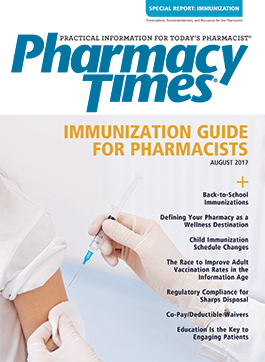Publication
Article
Supplements
Defining Your Pharmacy as a Wellness Destination
Author(s):
Successful pharmacists must be able to help themselves on both the business and clinical practice sides of the business.
The business and practice of pharmacy is rapidly changing. Successful pharmacists must be able to help themselves on both the business and clinical practice sides of the business. With an increased emphasis on providing the highest level of service at the lowest cost, the pharmacy remains an attractive site for patient care.
Pharmacists make up the most trusted group in the health care industry, according to the latest Meyocks Health Survey,1 followed by doctors and dentists. With consumer-driven healthcare becoming more popular, patients are increasingly relying on their pharmacist to play a key role in both their ongoing wellness and their preventive care. How can pharmacists elevate the level of care that they bring to their community? They can offer patients more than fulfillment of prescriptions, starting with immunizations.
BECOME THE COMMUNITY’S PREVENTIVE CARE EXPERT
The immunization market is growing fast and impacting the way pharmacists connect with their patients. Pharmacy owners have a unique opportunity to redefine their business by offering immunizations in their stores. In providing this service, pharmacies can transform from a destination for prescriptions to a valuable resource for preventive care. Patients will appreciate the easy access to these services and guidance from an expert and pharmacists will develop stronger relationships with their patients and improve their reputation within the community.
After understanding the benefits of implementing preventive care, pharmacists can offer their patients services such as medication therapy management (MTM), comprehensive medication reviews, medication synchronization, compliance packaging, and, where allowed by the state, point-of-care testing. These offerings will help pharmacists differentiate themselves from their competitors and provide additional resources to the community.
UNDERSTAND THE BUSINESS AND CLINICAL OPPORTUNITY
Several solutions are available to assist pharmacists with starting and growing an immunization practice. Pharmacists should look for a program that offers a comprehensive resource center, easy access, and ample resources, including compliance resource guides, support tools and templates, continuing education, and billing protocols.
With all 50 states now allowing immunizations in pharmacies, the biggest roadblock a pharmacist faces to providing immunizations is lack of education or interest in the service. Some pharmacists feel unequipped due to lack of time, resources, and skills. However, most pharmacists who invest time understanding the benefits of immunizing realize the tremendous impact it can have on their business.
In addition to building relationships with patients, immunizations drive revenue. Reimbursement analysis shows immunizations are one of the highest margin clinical services a pharmacy can provide. The act of administering an immunization is the first source of revenue, and it does not stop there. Providing immunizations drives traffic in to the pharmacy, which may help drive sales and attract new prescription customers.
On the business side, pharmacists are encouraged to use available resources and tools. For example, they should seek resources that will alleviate some of the administrative load, but keep them current and actively involved in the business. Reconciliation programs, inventory management solutions, and reimbursement consulting services are all ideal support programs that can help pharmacists accelerate their business. These programs can often be managed by nonclinical pharmacy technicians or employees, which enables the pharmacist to focus on patient care.
On the clinical side, engaging the services of an MTM team will help pharmacists understand and offer these services to the appropriate patients. When a pharmacist can easily identify patients that are a good fit for MTM, and can coordinate their medications, it benefits the patients and pharmacy. MTM improves medication adherence for patients and streamlines the monthly cost/payment of prescriptions.
COLLABORATE WITH OTHER HEALTH CARE PROVIDERS TO MANAGE PATIENT CARE
Another important part of offering immunizations in the pharmacy is engaging in a collaborative practice agreement (CPA). In more than 30 states, pharmacists can administer vaccines to walk-in patients because of a physician-signed CPA. In other states, pharmacists have independent authority and can administer vaccines without such a protocol. By establishing and nurturing relationships with local physicians, pharmacists can work alongside health care providers to build a clinical protocol. They can also utilize programs that provide the physician- signed protocol (applicable in their state), such as Cardinal Health’s Collaborative Practice program,2 which provides physicians with reviewed and signed documents that are state and vaccine specific.
By entering into a CPA, health care providers can develop trusting relationships to ensure they are meeting patients’ needs. It is important to maintain these mutually beneficial relationships so pharmacists, doctors, and other health care providers can help patients understand the services available to them. To ensure compliance with clinical and regulatory changes, the pharmacy should review its CPA annually. The regulations in states change from time to time and the CDC’s Advisory Committee on Immunization Practices3 meets quarterly to review data and update vaccine recommendations. Overall, engaging in a CPA will create ease of access for patients and help expand pharmacists’ roles as they implement preventive care.
LEARN FROM IMMUNIZATION SUCCESS STORIES
A Medicap Pharmacy owner, GRX (the Johansen Group), in Des Moines, Iowa, has long been a proponent of immunizations. GRX aggressively pursued screening for immunizations, with protocols in place for influenza, both pneumococcal vaccines, herpes zoster, and Tdap (tetanus, diphtheria, and pertussis). The pharmacy dispenses flu shots in several locations—including on-site employer clinics, health fairs, schools, fire and police departments, city and state offices, churches, fraternity and sorority houses, hotels, and nursing home/assisted living/ independent living facilities—attributing its success to having resources in their stores that are knowledgeable about vaccines. Nearly 7000 flu shots were provided to central Iowa patients last year, not inclusive of the pneumonia vaccines administered at the same time.
A new leader in immunization services is Nancy Poore, owner of The Medicine Shoppe Pharmacy in Chittenango, New York. In only her second year of operation, she administered the flu vaccine to over 300 patients. Much like GRX, Nancy pursued schools, churches, and community groups.
Beverly Schaefer at Katterman’s Pharmacy in Seattle strives to reinvent her business every 3 years with unique offerings for her patients. Her pharmacy was 1 of the first in the country to start doing immunizations in 1996. With many years of experience, Beverly and her partner, Steve Cone, recently tapped into a niche market: travelers looking for a quick, convenient way to receive necessary travel vaccinations. This service has attracted travelers from over an hour away and resulted in $600 to $1200 in sales and consultation fees for each appointment. Her advice to other pharmacists interested in an immunization program comprises these 6 steps:
- Start small by offering flu vaccinations.
- Research other vaccinations pharmacists administer according to state regulations and build your immunization offering accordingly.
- Market your program by informing the community that your pharmacy offers immunizations; it could be an ad in the paper or a large sign on your front door.
- Capture your own customers first. Once they are onboard, they will sell your pharmacy through word-of-mouth.
- Think about the front end of your store. How can you align these products with your vaccination offerings?
- Recognize your community’s needs and reinvent your pharmacy based on these observations.
GRX, The Medicine Shoppe Pharmacy, and Katterman’s Pharmacy have made significant impacts on the health and well-being of their customers and community while making a significant contribution to their bottom line.
Through clinical services, like MTM and immunizations, pharmacists have a unique opportunity to practice at the top of their license, continue to build their patient relationships, and, ultimately, provide better outcomes.
REFERENCES
1. Salazar D. Survey: pharmacists lead pack when it comes to patient trust. Drug Store News website. drugstorenews.com/article/survey-pharmacists-lead-packwhen- it-comes-patient-trust. Published July 12, 2016. Accessed July 22, 2017.
2. Transform your pharmacy into a year-round vaccination destination. Cardinal- Health website. cardinalhealth.com/en/services/retail-pharmacy/patient-solutions/ wellness-advantage/immunizations-solutions/collaborative-practice-program. html. Accessed July 19, 2017.
3. Advisory Committee on Immunization Practices. CDC website. cdc.gov/vaccines/ acip/index.html. Updated June 23, 2017. Accessed July 19, 2017. Unless otherwise attributed, the statements and opinions of this article represent the viewpoints and expertise of the author.
John Fiacco is vice president of pharmacy transition services at Cardinal Health, Dublin, Ohio.

Newsletter
Stay informed on drug updates, treatment guidelines, and pharmacy practice trends—subscribe to Pharmacy Times for weekly clinical insights.






